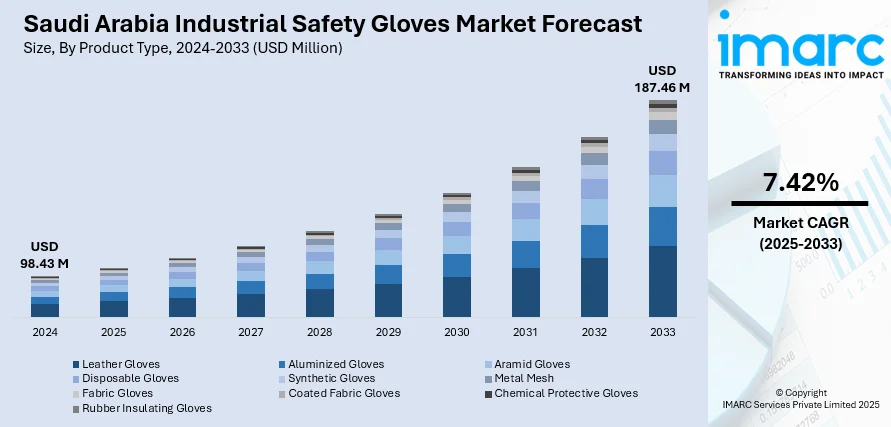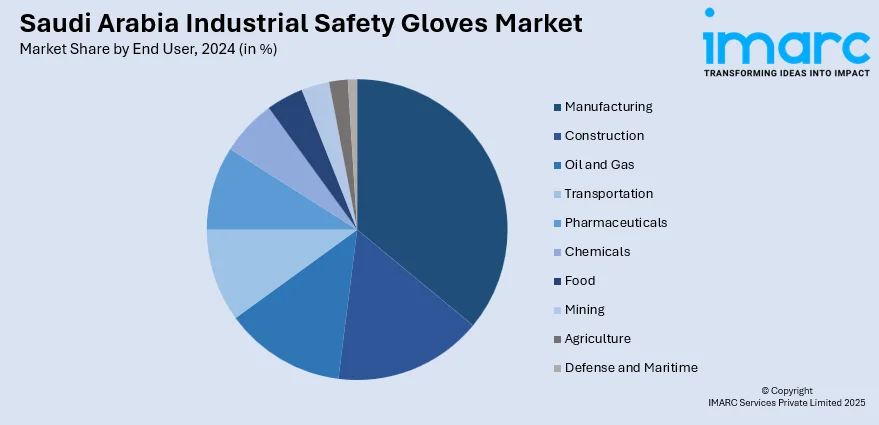
Saudi Arabia Industrial Safety Gloves Market Size, Share, Trends and Forecast by Product Type, End User, and Region, 2025-2033
Saudi Arabia Industrial Safety Gloves Market Overview:
The Saudi Arabia industrial safety gloves market size reached USD 98.43 Million in 2024. Looking forward, IMARC Group expects the market to reach USD 187.46 Million by 2033, exhibiting a growth rate (CAGR) of 7.42% during 2025-2033. The market is witnessing significant growth due to growing emphasis on occupational safety, increased industrial activity, and rising investments in construction, oil, gas, and manufacturing sectors. Government regulations mandating worker protection and the adoption of high-performance gloves in hazardous environments are driving demand. Technological advancements and local manufacturing support further strengthen the market, contributing to the overall Saudi Arabia industrial safety gloves market share.
|
Report Attribute
|
Key Statistics
|
|---|---|
|
Base Year
|
2024 |
|
Forecast Years
|
2025-2033
|
|
Historical Years
|
2019-2024
|
| Market Size in 2024 | USD 98.43 Million |
| Market Forecast in 2033 | USD 187.46 Million |
| Market Growth Rate 2025-2033 | 7.42% |
Saudi Arabia Industrial Safety Gloves Market Trends:
Rising Industrial and Infrastructure Activity
Saudi Arabia's ongoing industrial expansion and infrastructure development are key drivers of demand in the industrial safety gloves market. The government’s Vision 2030 initiative is fueling large-scale projects across construction, oil and gas, and manufacturing sectors, all of which involve high-risk tasks requiring robust safety measures. For instance, in February 2025, Saudi Arabia announced its plans to invest around $1 trillion in infrastructure by 2030, as stated by Economy Minister Faisal Al-Ibrahim. This investment aims to bolster the non-oil sector and stimulate economic growth, with the Public Investment Fund playing a key role in fostering innovation and public-private partnerships. Workers in these environments face exposure to sharp tools, chemicals, heat, and mechanical hazards, making protective gloves essential for daily operations. In construction, gloves are used for handling materials, operating machinery, and safeguarding against abrasions. In the oil and gas sector, specialized gloves provide resistance to chemicals, punctures, and extreme temperatures. Similarly, manufacturing facilities increasingly mandate the use of task-specific gloves to comply with safety regulations. As these sectors continue to grow and prioritize worker safety, the consistent need for durable, high-performance gloves is significantly boosting the Saudi Arabia industrial safety gloves market.

Stricter Occupational Safety Regulations
The Saudi government is reinforcing workplace safety through stricter enforcement of occupational health and safety regulations, prompting industries to adopt certified personal protective equipment, including industrial safety gloves. These regulations apply across construction, oil and gas, manufacturing, and logistics sectors, where workers are routinely exposed to mechanical, thermal, and chemical risks. Regulatory bodies are conducting more frequent inspections and audits to ensure compliance with safety protocols, pushing employers to invest in high-quality, standard-compliant gloves. For instance, in May 2025, Saudi Arabia launched six major initiatives at the GOSH7 conference to enhance occupational safety and health standards. Minister Eng. Ahmed Al-Rajhi emphasized the country's commitment to safe work environments, promoting holistic wellbeing and positioning Riyadh as a global hub for workplace health, aligning with Saudi Vision 2030. As a result, demand is rising for gloves that meet international safety certifications and offer protection without compromising comfort and dexterity. This compliance-driven shift is also encouraging companies to upgrade from basic to specialized gloves suited for different tasks. The overall regulatory momentum is playing a crucial role in improving workplace conditions and driving sustained Saudi Arabia industrial safety gloves market growth across the country.
Saudi Arabia Industrial Safety Gloves Market Segmentation:
IMARC Group provides an analysis of the key trends in each segment of the market, along with forecasts at the country and regional levels for 2025-2033. Our report has categorized the market based on product type and end user.
Product Type Insights:
- Leather Gloves
- Aluminized Gloves
- Aramid Gloves
- Disposable Gloves
- Synthetic Gloves
- Metal Mesh
- Fabric Gloves
- Coated Fabric Gloves
- Chemical Protective Gloves
- Rubber Insulating Gloves
The report has provided a detailed breakup and analysis of the market based on the product type. This includes leather gloves, aluminized gloves, aramid gloves, disposable gloves, synthetic gloves, metal mesh, fabric gloves, coated fabric gloves, chemical protective gloves, and rubber insulating gloves.
End User Insights:

- Manufacturing
- Construction
- Oil and Gas
- Transportation
- Pharmaceuticals
- Chemicals
- Food
- Mining
- Agriculture
- Defense and Maritime
A detailed breakup and analysis of the market based on the end user have also been provided in the report. This includes manufacturing, construction, oil and gas, transportation, pharmaceuticals, chemicals, food, mining, agriculture, and defense and maritime.
Regional Insights:
- Northern and Central Region
- Western Region
- Eastern Region
- Southern Region
The report has also provided a comprehensive analysis of all the major regional markets, which include Northern and Central Region, Western Region, Eastern Region, and Southern Region.
Competitive Landscape:
The market research report has also provided a comprehensive analysis of the competitive landscape. Competitive analysis such as market structure, key player positioning, top winning strategies, competitive dashboard, and company evaluation quadrant has been covered in the report. Also, detailed profiles of all major companies have been provided.
Saudi Arabia Industrial Safety Gloves Market News:
- In October 2024, U.S. Medical Glove Company secured an $80 million contract with Medeco Protective Safety Equipment to manufacture 12 exam glove-making machines, to be delivered to Saudi Arabia in 2025. This partnership marks the second phase of a collaboration aimed at expanding production capabilities for medical gloves in the region.
Saudi Arabia Industrial Safety Gloves Market Report Coverage:
| Report Features | Details |
|---|---|
| Base Year of the Analysis | 2024 |
| Historical Period | 2019-2024 |
| Forecast Period | 2025-2033 |
| Units | Million USD |
| Scope of the Report |
Exploration of Historical Trends and Market Outlook, Industry Catalysts and Challenges, Segment-Wise Historical and Future Market Assessment:
|
| Product Types Covered | Leather Gloves, Aluminized Gloves, Aramid Gloves, Disposable Gloves, Synthetic Gloves, Metal Mesh, Fabric Gloves, Coated Fabric Gloves, Chemical Protective Gloves, Rubber Insulating Gloves |
| End Users Covered | Manufacturing, Construction, Oil and Gas, Transportation, Pharmaceuticals, Chemicals, Food, Mining, Agriculture, Defense and Maritime |
| Regions Covered | Northern and Central Region, Western Region, Eastern Region, Southern Region |
| Customization Scope | 10% Free Customization |
| Post-Sale Analyst Support | 10-12 Weeks |
| Delivery Format | PDF and Excel through Email (We can also provide the editable version of the report in PPT/Word format on special request) |
Key Questions Answered in This Report:
- How has the Saudi Arabia industrial safety gloves market performed so far and how will it perform in the coming years?
- What is the breakup of the Saudi Arabia industrial safety gloves market on the basis of product type?
- What is the breakup of the Saudi Arabia industrial safety gloves market on the basis of end user?
- What is the breakup of the Saudi Arabia industrial safety gloves market on the basis of region?
- What are the various stages in the value chain of the Saudi Arabia industrial safety gloves market?
- What are the key driving factors and challenges in the Saudi Arabia industrial safety gloves market?
- What is the structure of the Saudi Arabia industrial safety gloves market and who are the key players?
- What is the degree of competition in the Saudi Arabia industrial safety gloves market?
Key Benefits for Stakeholders:
- IMARC’s industry report offers a comprehensive quantitative analysis of various market segments, historical and current market trends, market forecasts, and dynamics of the Saudi Arabia industrial safety gloves market from 2019-2033.
- The research report provides the latest information on the market drivers, challenges, and opportunities in the Saudi Arabia industrial safety gloves market.
- Porter's five forces analysis assist stakeholders in assessing the impact of new entrants, competitive rivalry, supplier power, buyer power, and the threat of substitution. It helps stakeholders to analyze the level of competition within the Saudi Arabia industrial safety gloves industry and its attractiveness.
- Competitive landscape allows stakeholders to understand their competitive environment and provides an insight into the current positions of key players in the market.
Need more help?
- Speak to our experienced analysts for insights on the current market scenarios.
- Include additional segments and countries to customize the report as per your requirement.
- Gain an unparalleled competitive advantage in your domain by understanding how to utilize the report and positively impacting your operations and revenue.
- For further assistance, please connect with our analysts.
 Request Customization
Request Customization
 Speak to an Analyst
Speak to an Analyst
 Request Brochure
Request Brochure
 Inquire Before Buying
Inquire Before Buying




.webp)




.webp)












